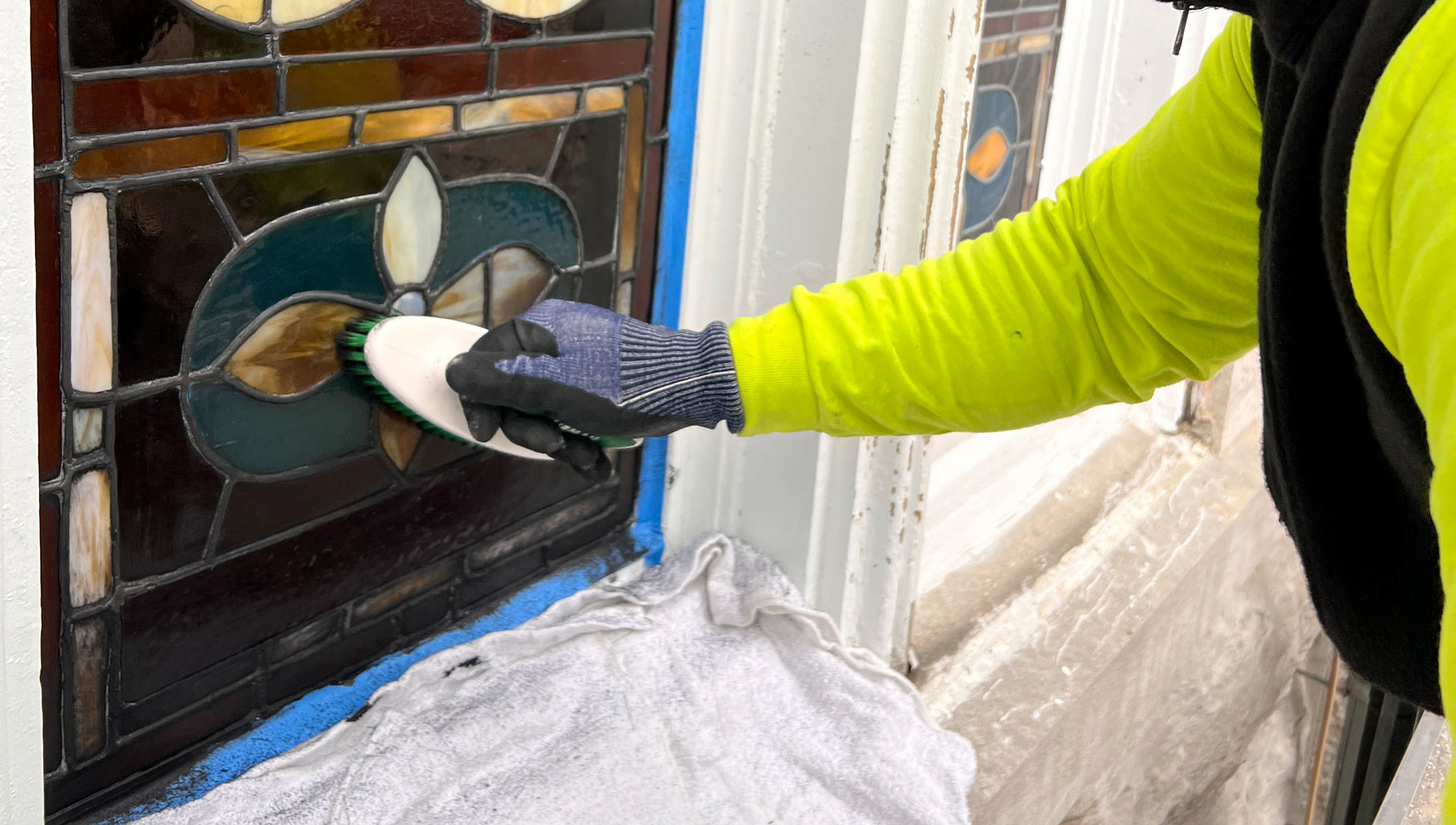
Stained glass windows are more than architectural accents; they are intricate works of art that tell stories, evoke emotions, and capture light in ways unmatched by any other medium. From monumental cathedrals to intimate chapels, these windows are often the crown jewels of historic buildings. However, the passage of time takes its toll on even the most robust masterpieces. That’s where the expert work of stained glass shops plays a critical role, ensuring these beloved treasures not only endure but shine brighter than ever.
If you’re a preservationist or church leader dedicated to safeguarding historic stained glass windows, understanding a stained glass shop’s meticulous art and science of restoration will help you make informed decisions about their care.
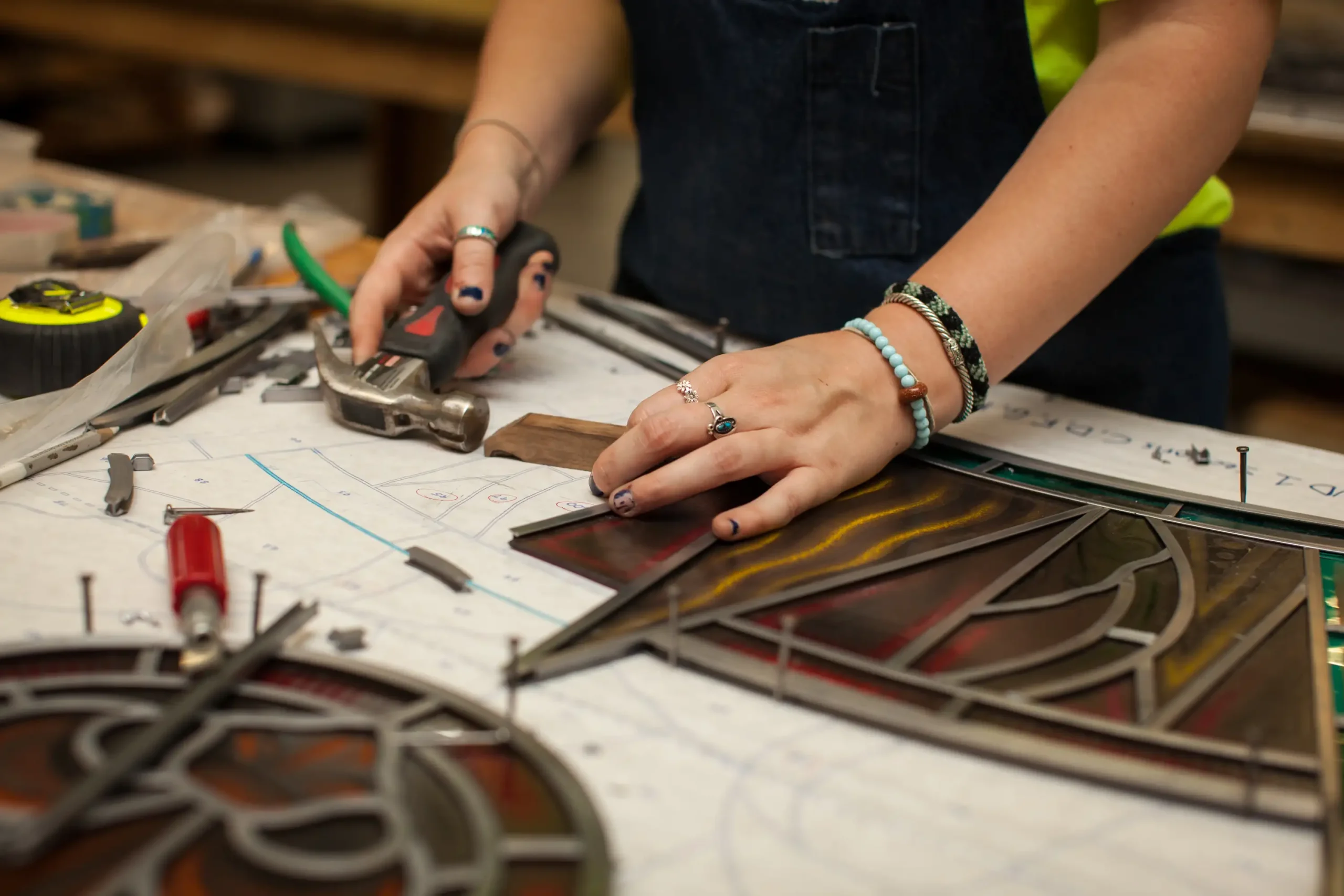
Understanding the Culprits Behind Deterioration
Preserving stained glass windows begins with comprehending the myriad forces that contribute to their gradual deterioration. These awe-inspiring works of art are fragile ecosystems, constantly under siege from environmental hardships, structural pressures, and even misunderstanding in their care. By identifying these culprits, we can better appreciate the intricate challenges of maintaining their former glory while preventing further harm.
Environmental Impact
The most persistent enemy of stained glass windows is the relentless force of nature. Prolonged exposure to environmental conditions such as humidity and temperature fluctuations can wreak havoc. Humidity introduces moisture into the glass and its lead cames, fostering corrosion and sometimes causing panes to haze or crack over time. Abrupt temperature variations, meanwhile, exacerbate the problem, triggering expansion and contraction in the materials, which ultimately weaken the window’s integrity.
Acid rain poses an equally aggressive threat. Atmospheric pollutants dissolved in rainwater create a mildly acidic solution that etches and degrades the delicate surface of the glass. Over decades, this corrosive process strips away not just the glass itself, but also its vibrant painted details, leaving the window dulled and incomplete. The harm is compounded by UV rays, which can cause pigments to fade, especially in hand-painted sections that rely on centuries-old firing techniques to bond color to the glass.
Even airborne particulates – dirt, dust, and pollution – settle onto the surface, forming a gritty layer that obscures the luminosity of the glass. These particles not only blemish the window’s appearance but can scratch or further weaken it during cleaning if removed improperly.
Structural Strain and Wear
Beyond environmental damage, the very buildings in which stained glass windows reside can become culprits in their decline. Historic structures often endure the ravages of time, from settling foundations to shifting walls. This movement places immense strain on their windows, which rely heavily on being evenly supported to maintain their contours and alignment. Over time, disturbances can warp or distort the framework, leaving panes misaligned or vulnerable to fractures.
Vibrations caused by daily activities also play a role; whether it’s the resonance of organ music reverberating through a cathedral, the footsteps of visitors shuffling past, or nearby construction work, these subtle yet consistent movements place significant stress on the lead cames that hold the glass together. Often unnoticed, this cumulative pressure can manifest visible cracks or weakened solder joints, threatening the stability of the pane.
Wear and tear from aging masonry or improper repairs further exacerbate the issue. Deterioration in the building’s stone or wood surrounds can cause gaps or uneven weight distribution on the window frame. Insensitive restoration attempts, such as cleaning with harsh chemicals or improper abrasive techniques, may scar painted decorations or weaken already compromised sections. Even overtightening or adjusting window supports during maintenance risks causing new stress points on a centuries-old creation.
Preserving a stained glass window requires a holistic understanding of these factors, underscoring the need for a professional stained glass shop and sensitivity to the delicate balance of materials involved. Without such vigilance, even the most stunning examples of this centuries-old art form may lose their brilliance – or their rightful place in history.
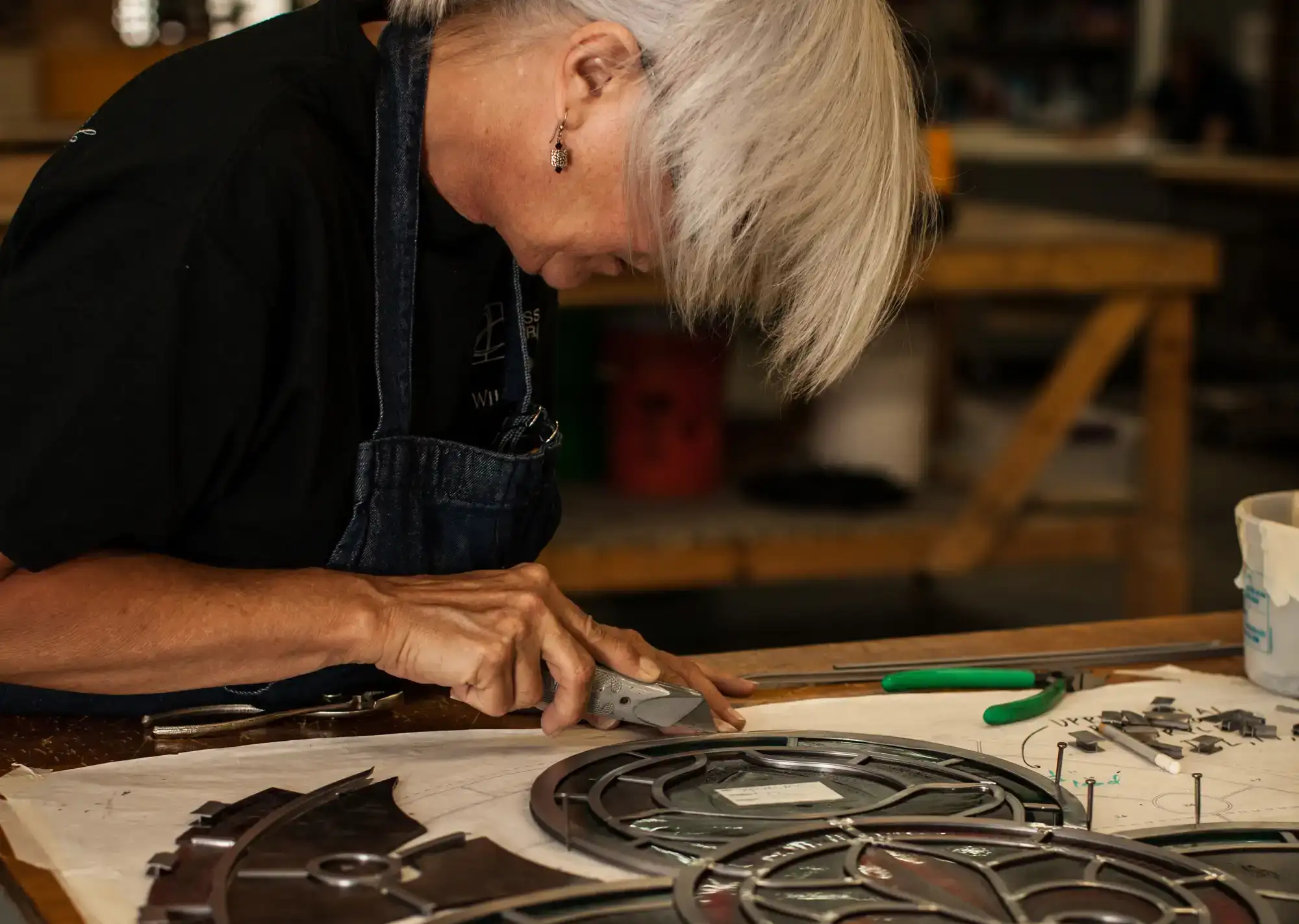
Step One in Restoration: Initial Assessment
Every stained glass window is a singular masterpiece with its own set of challenges and intricacies, which makes the initial assessment phase one of the most critical steps in the restoration process. This stage lays the foundation for all subsequent work, ensuring that the preservation plan is both comprehensive and tailored to the specific needs of the window. Professional stained glass shops, such as Willet Stained Glass Studios, approach this phase with a meticulous blend of artistry and technical expertise, employing advanced tools and techniques to guarantee no detail goes unnoticed.
Thorough Inspection and Documentation
The process begins with an in-depth inspection by the stained glass shop, where skilled artisans and restorers collaborate to evaluate every aspect of the window’s construction and current condition. Specialists examine the glass panes themselves, looking for signs of cracking, hazing, or corrosion, as well as damage to the painted designs or fading caused by UV exposure. Equally crucial is the condition of the lead cames – the metal framework holding the glass in place – which may show signs of buckling, corrosion, or weakened solder joints because of age or stress.
Modern restoration efforts often employ the latest technology to ensure unparalleled accuracy during these evaluations. High-resolution photography captures fine details that may not be immediately visible to the naked eye, such as microfractures or subtle distortions in the leading. Advanced imaging tools and digital mapping can also be used to chart the overall structure of the window, identifying any shifts, warping, or areas under pressure. These records serve not only as a diagnostic tool but also as a permanent historical archive, ensuring a precise reference point for future generations.
Comprehensive Condition Analysis
Beyond the physical examination of the window itself, the surrounding architecture is also assessed by the stained glass shop during this phase. The stability of the window frame and the supporting masonry or woodwork is evaluated to determine if external factors, such as structural settling or water damage, are contributing to the issues at hand. The interplay between the stained glass and its environment is essential to consider, as ignoring these factors could jeopardize restoration efforts or lead to further complications down the line.
Detailed notes and sketches accompany the stained glass shop’s photographic documentation to create a thorough blueprint of the window’s status. This mapping organizes information into clear categories, addressing colors, textures, patterns, and even subtle variations in the original craftsmanship. Where possible, historical records may also be consulted to offer insight into the original artist’s techniques or previous restoration attempts, creating a clearer picture of how best to preserve these historic treasures.
Custom Restoration Planning
Once the stained glass shop analyzes the window in detail, the information is used to formulate a tailored restoration plan. This plan accounts for every nuance of the window’s condition, ensuring that the preservation efforts align with both the technical requirements of the materials and the artistry of the original design. Specific areas of immediate concern may be prioritized, such as addressing structural weaknesses or halting ongoing deterioration from environmental factors. The restoration team carefully assesses the feasibility of each intervention to ensure that it will enhance, rather than compromise, the window’s integrity.
The initial assessment by the stained glass shop is a time-intensive but indispensable stage that determines the success of the entire restoration effort. By leveraging professional expertise and innovative tools, stained glass restoration studios ensure that every window is treated with the care and respect it deserves. Whether the goal is to stabilize a fragile piece, revive its original beauty, or prepare it for another century of display, this phase ensures the preservation process is rooted in precision, reverence, and an unwavering commitment to excellence.
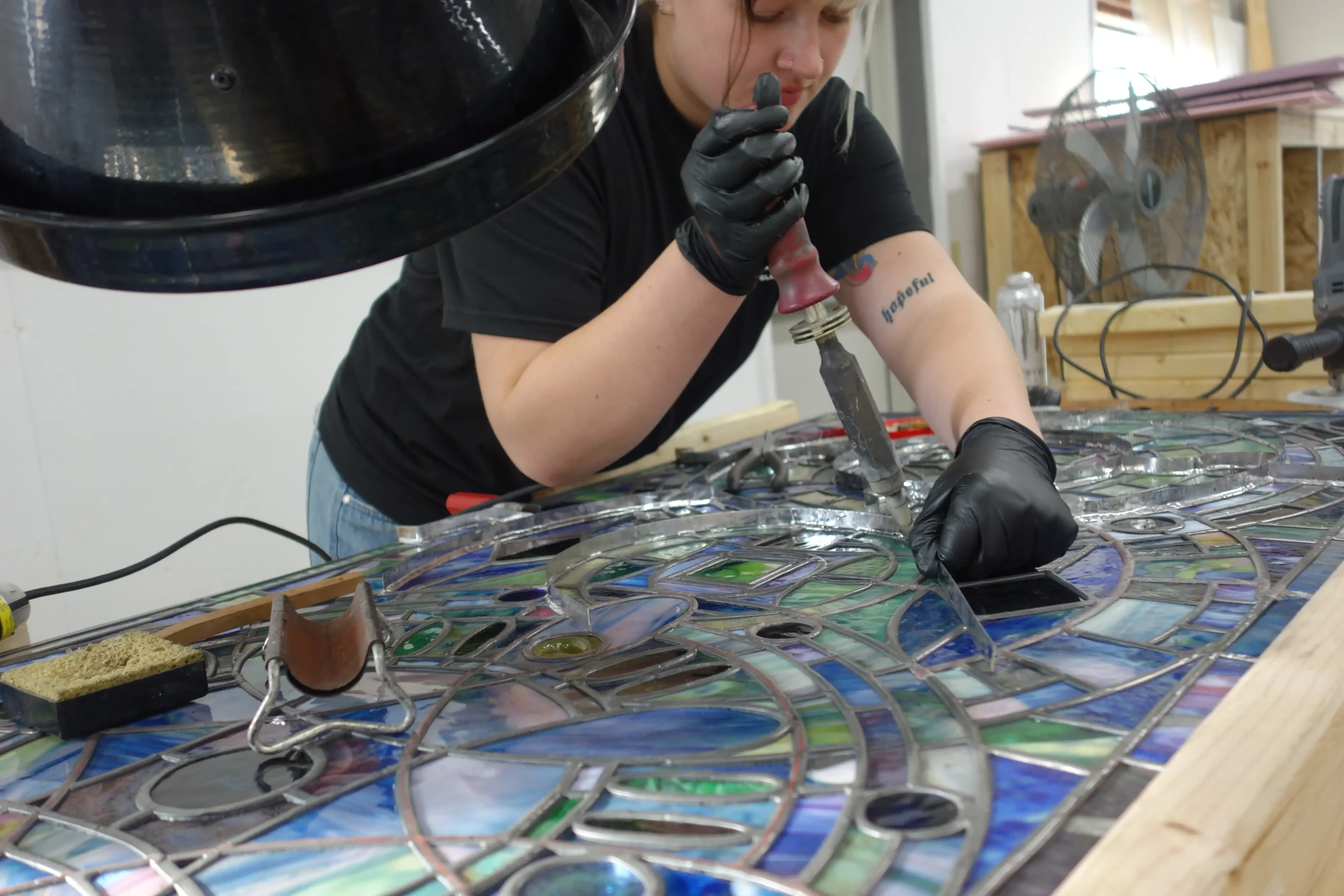
Gentle Cleaning Techniques for Brilliance
One of the most effective ways to restore the luster of a historic stained glass window is through meticulous cleaning. However, this process demands an extraordinary level of care, precision, and expertise to avoid inadvertently damaging the glass or its painted details. Cleaning centuries-old stained glass is not a mere surface-cleaning task but a delicate art form, requiring a deep understanding by the stained glass shop of both the materials and the window’s historical significance.
Non-Abrasive Methods
Over time, layers of dust, grime, and pollutants accumulate on stained glass, muting its vibrancy and masking intricate details. Given the fragile and often irreplaceable nature of aged stained glass, non-abrasive cleaning methods are essential. Professionals typically employ pH-balanced cleaners specifically formulated for historic preservation. These solutions are applied sparingly using soft brushes, natural sponges, or cotton swabs to gently lift grime from the surface without scratching or degrading the glass.
The stained glass shop begins the process with a careful dry removal of loose debris such as dirt and cobwebs, ensuring even this initial step does not apply undue pressure to the glass or surrounding lead cames. Next, wet cleaning is implemented in small, controlled sections to limit exposure to moisture and to focus on precision. For especially stubborn areas, distilled water combined with trace amounts of mild detergent may be used to dissolve residues, always followed by a thorough yet gentle wiping with clean, lint-free cloths to dry the glass thoroughly.
Respecting Painted Details
An even greater challenge for the stained glass shop arises when cleaning painted stained glass panels. These windows often feature hand-painted details, such as delicate linework, shading, or enamels that have been kiln-fired into the surface of the glass. While these painted features can endure for centuries, they are vulnerable to wear, flaking, and fading, particularly if mishandled. Cleaning methods for painted details are conservative and deliberate, often requiring the expertise of specialized artisans who understand the balance between preservation and restoration.
To protect these intricate designs, interventions are approached with the philosophy of “less is more.” Tests are often conducted on inconspicuous areas to determine a safe cleaning approach. Stained glass shops select cleaning tools with the utmost care; for example, tiny cotton swabs may be used to gently work around painted areas, ensuring that no moisture is allowed to seep into the paint layers. If conservation experts determine that the paint is at risk of peeling, cleaning may be postponed until appropriate stabilization measures are undertaken.
Removing Hazardous Deposits
Certain historic stained glass windows, especially those located in industrial or urban settings, can accumulate deposits of harmful substances such as soot, acidic grime, or mineral buildup from water exposure. These materials not only obscure the glass but can chemically interact with its surface, leading to long-term degradation if left untreated. Professional stained glass shops use microscopic inspection to identify such hazardous residues and develop tailored removal strategies. Techniques such as ionized water rinses or specialized poultices may be employed to extract corrosive substances without physically scrubbing the delicate surfaces.
Balancing Preservation with Restoration
Cleaning a stained glass window is not simply an act of restoration – it is an act of preservation. The goal is not to return the glass to a state of artificial perfection but to honor its aged beauty while safeguarding its structural and artistic integrity. Decisions about the depth of cleaning are made collaboratively by stained glass shops, conservators, historians, and artisans. Often, deliberate traces of aging, such as light weathering or slight surface patina, are left intact to celebrate the window’s storied past.
From beginning to end, cleaning historic stained glass requires an unwavering commitment to precision, patience, and respect for the artistry of its original creation. By relying on non-invasive methods, safeguarding painted details, and addressing unique challenges posed by time and environment, stained glass shops ensure that these luminous treasures continue to inspire awe for generations to come.
Protective Measures to Safeguard Longevity
Proper restoration of a historic stained glass window extends far beyond the immediate act of cleaning and repair. Once a window has been meticulously rejuvenated, implementing protective measures is critical for the stained glass shop to ensure its long-term preservation. These efforts not only shield the window from environmental harm but also account for the unique vulnerabilities inherent in such an aging yet irreplaceable medium. By combining traditional craftsmanship with modern technology, caretakers of stained glass windows can achieve a blend of historic authenticity and contemporary resilience.
UV Coatings
One of the primary threats to stained glass is prolonged exposure to sunlight, which can cause fading, discoloration, and weakening of the materials over time. UV-resistant coatings offer innovative solutions, forming an invisible layer that absorbs harmful ultraviolet radiation while allowing visible light to pass through. These coatings are carefully selected to avoid interfering with the natural brilliance of the glass, preserving its aesthetic appeal while providing robust protection. Applied with precision by the stained glass shop, the UV coating helps mitigate the risk of pigment degradation and ensures the vivid colors of the stained glass remain vibrant for years to come.
Advanced formulations of UV coatings are now available that cater specifically to historic preservation efforts. These coatings are reversible, ensuring that future generations of conservators can adjust or replace them, if necessary, without compromising the integrity of the original material. Additionally, because each stained glass window is unique, conservation experts often conduct laboratory tests or site-specific assessments to identify the most appropriate protective solutions.
Improved Ventilation Systems
Environmental factors play a significant role in the deterioration of stained glass, particularly in buildings where fluctuating temperatures and humidity levels are prevalent. Condensation is a major issue; moisture droplets forming on or around the glass can not only obscure the window but also promote corrosion of lead cames and encourage the growth of mold or mildew. To combat this, restoration projects often integrate enhancements to the surrounding building’s ventilation systems, ensuring proper air flow and minimizing the chance of moisture buildup.
Modern engineering solutions allow for discreet ventilation system designs that complement the architectural character of historic structures. These systems regulate temperature and humidity within the building, creating a stable microclimate around the stained glass that prevents material stress. When combined with dehumidifiers or custom insulated glazing, these techniques provide a crucial safeguard against environmental damage.
Storm Protection Systems
Many historic stained glass windows are situated in vulnerable locations, such as church spires or exposed elevations, where they face an increased risk from storms, hail, and high winds. To address this, stained glass shops may recommend the installation of external protection, such as clear protective glazing panels or laminated glass shields. These barriers offer a physical defense against impact while preserving the visibility and accessibility of the stained glass.
Modern protective glazing systems are crafted to remain visually unobtrusive. High-quality materials ensure that reflections or optical distortions are minimized so that the beauty of the stained glass can continue to be appreciated. Importantly, these systems are designed to promote airflow between the stained glass and the protective layer, preventing the buildup of trapped moisture.
Additionally, in areas prone to severe weather, reinforcement of window frames may be necessary to ensure that the surrounding infrastructure can bear the added protective measures without compromising the historic fabric of the building.
Regular Maintenance and Monitoring
A stained glass shop’s commitment to safeguarding stained glass does not end once restoration and protection measures are in place. Routine inspections and maintenance form the foundation of long-term conservation efforts. Professional stained glass shops conduct periodic assessments, examining both the glass itself and its broader environment for signs of emerging damage. Loose lead cames, shifting panels, or weakening paint layers are among the issues that can be identified early through vigilant monitoring.
Advanced technologies such as infrared imaging and digital mapping are increasingly being utilized to track the health of stained glass over time. These tools allow stained glass shops to detect hidden problems, such as thermal stress or microfractures, that may not be visible to the naked eye. Timely intervention based on such assessments significantly reduces the likelihood of costly or invasive repairs in the future.
Incorporating Protective Barriers While Respecting Aesthetics
Balancing the need for robust protection with the desire to preserve the aesthetic and historical authenticity of stained glass windows is paramount. Protective solutions are always tailored to the specific characteristics of each window, ensuring that intervention enhances its longevity without diminishing its artistic and architectural value.
Collaborating closely with architects, historians, and engineers, stained glass specialists work to devise strategies that integrate seamlessly with both the window itself and its surrounding space. By incorporating reversible and minimally invasive techniques, they help maintain the delicate equilibrium between preservation and innovation.
A Holistic Approach to Preservation
Protecting historic stained glass windows is more than a technical exercise – it is a deep commitment to preserving cultural heritage for future generations. Each measure taken, from UV coatings to ventilation improvements and active maintenance, extends the window’s lifespan while honoring the artistry and craftsmanship of its original creators. When approached with care, respect, and expertise, every protective effort becomes part of the window’s living narrative, ensuring its ability to inspire and captivate long into the future.
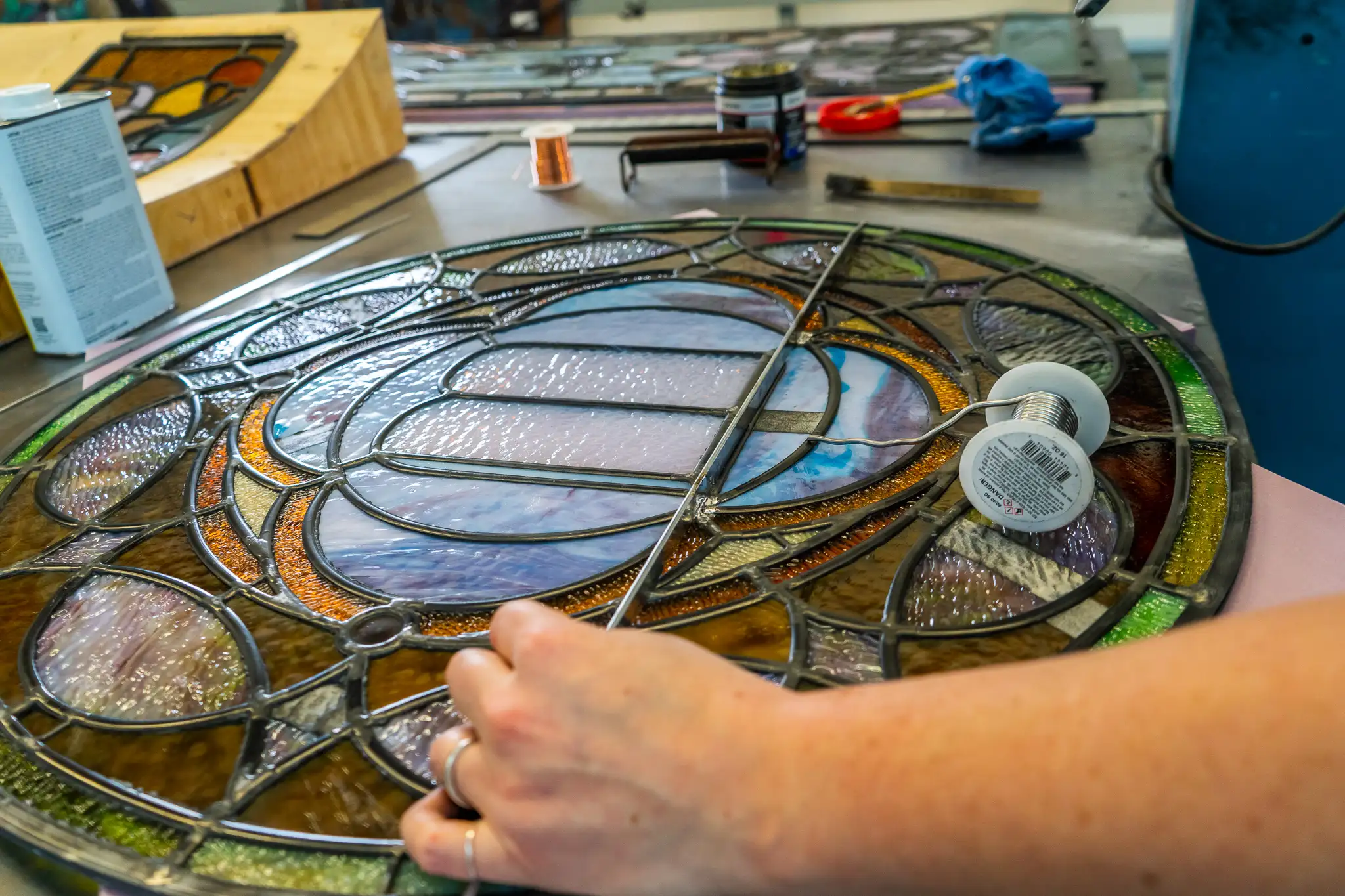
Partnering with Willet Stained Glass Studios
If you’re seeking unrivaled expertise for your stained glass restoration, Willet Stained Glass Studios stands as North America’s most-qualified stained glass shop. With more than 125 years of experience, our talented craftspeople have restored the luminous beauty of stained glass in more than 36,000 buildings.
From free inspections and appraisals to on-site installations and 10-year warranties, Willet Stained Glass Studios offers unmatched artistry and service. Our meticulous restoration process, from matching original materials to enhancing protective measures, ensures the preservation of your stained glass heritage for generations.
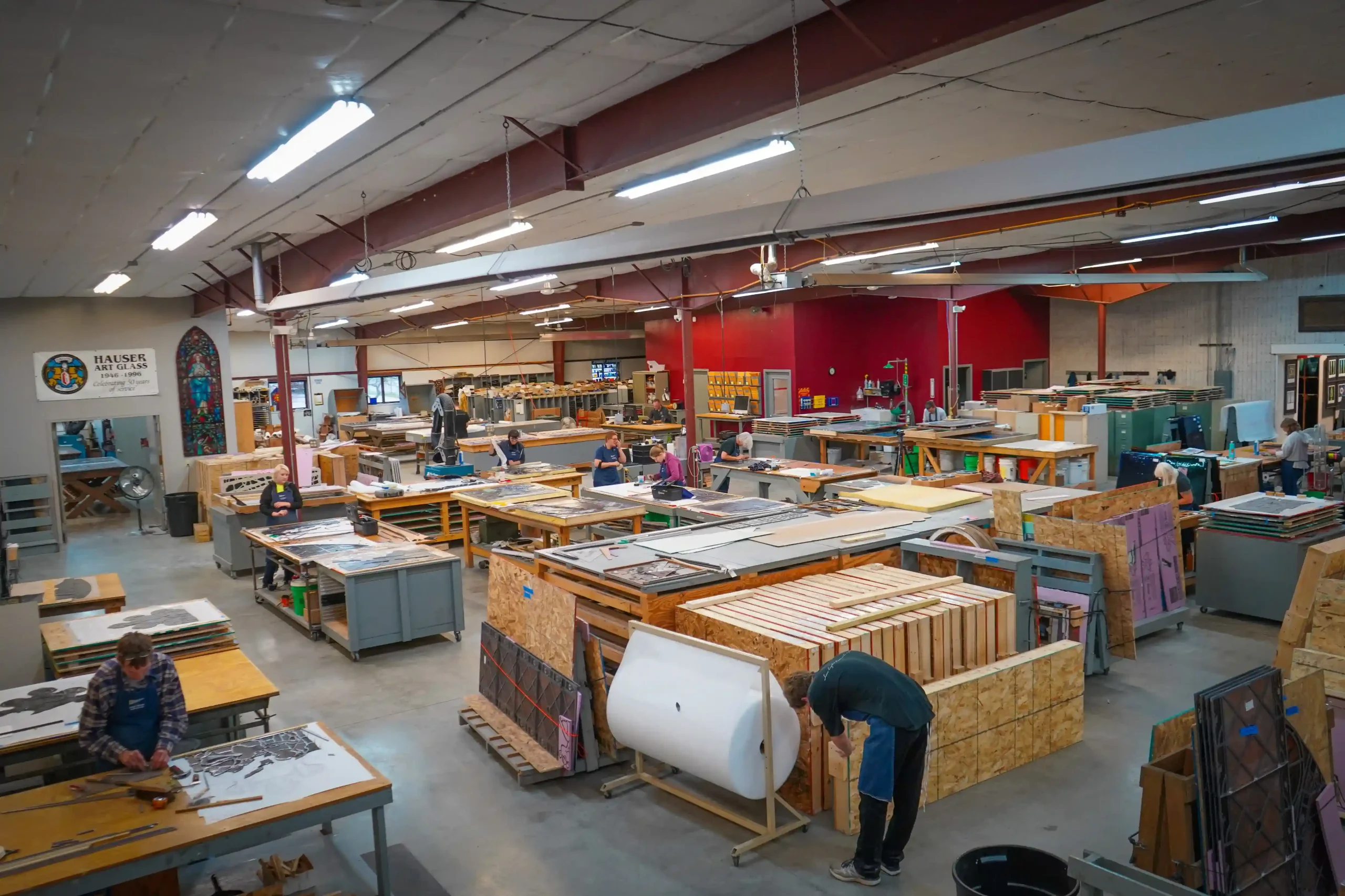
Keeping the Light Alive
Historic stained glass windows are more than just decorative elements; they are cultural and historical treasures that connect us to the past. Their preservation is a commitment to respecting the craftsmanship of those who came before us and ensuring future generations experience the same sense of wonder.
Whether you’re a preservationist dedicated to restoring a town’s historic church or a leader seeking to maintain your congregation’s heritage, proper care and restoration of stained glass require expertise. Willet Stained Glass Studio’s dedication to craftsmanship means you can trust that these masterpieces will continue to inspire for decades to come.
Preserve the light, honor the craft, and ensure these luminous treasures remain a source of beauty and inspiration for generations. Contact Willet Stained Glass Studios today to schedule your free inspection and appraisal.
Interested in restoring or enhancing your church’s windows?
Contact Willet Stained Glass Studios today for a free inspection and consultation. Our team is here to help you protect and revitalize your stained glass while honoring its heritage and artistry.







